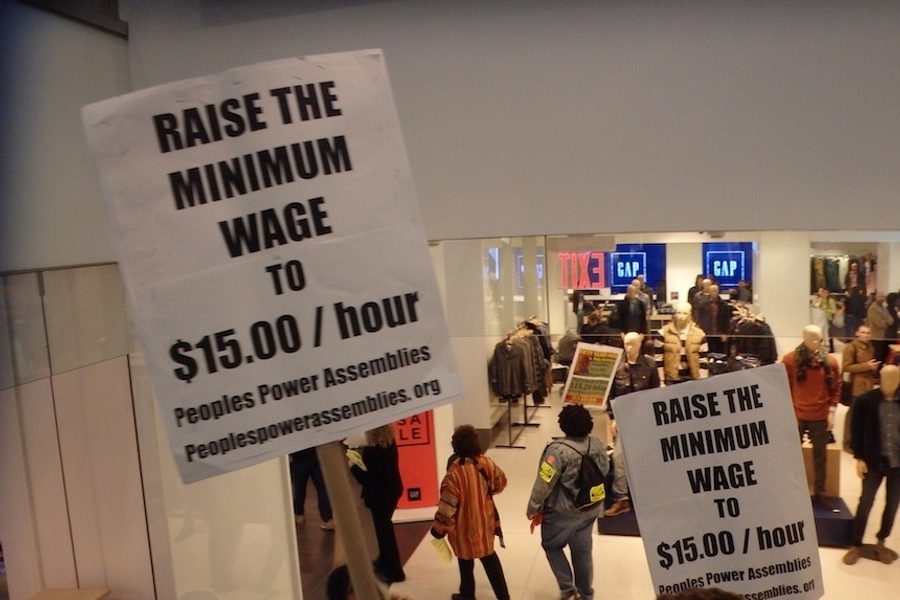
As a national conversation on raising the minimum wage gains steam, all eyes are turning to Seattle, where the city council appears poised to raise the wage floor to $15 per hour. Seattle would leapfrog Washington, D.C. and two neighboring Maryland counties, where lawmakers voted in December 2013 to increase the minimum wage to $11.50 per hour.
While a bill has yet to be proposed, there is strong movement that has secured public and legislative support. Since mid-2013, Seattle has been a hotbed of low-wage worker rallies for a $15 minimum wage, as part of the national Fight for 15 movement backed by the Service Employees International Union. According to a recent poll, 68 percent of the city’s population is in favor of the measure, and all nine of the City Council members endorse the idea. Socialist City Council member Kshama Sawant made it a centerpiece of her campaign this fall, and new Mayor Ed Murray has said, “it is not a matter of if we get to $15 per hour, but when and how.” A recommendation is expected to be delivered to the city council by May.
The $15 minimum would be a boon to low-wage workers, who are disproportionately women. According to the National Women’s Law Center, women hold two-thirds of all low-wage jobs nationwide. And many of those women have families who depend on their earnings. According to the Pew Research Center, 40 percent of households with children depend on mothers as the sole or primary wage earners across the country.
Take Alma Mayorga, a Seattle worker who earns $11 an hour as a homecare provider at Victoria Park, an affordable senior living community. She supports her 9-year-old daughter and her 15-year-old son. For a family of three in Washington State, the poverty line is $19,790. For Mayorga, a wage of $11 per hour comes out to approximately $22,880 per year – just above that.
Mayorga believes that the raise of the minimum wage to $15 an hour would not only help her cover her essential expenses, but also give her a safety net and a higher quality of life. She wants to be able to save for emergencies and to enjoy recreational activities with her children. “I would like to take my children to the theater,” she says.
Seattle is hardly the only city where the movement towards a living wage is gaining ground. In addition to the Maryland and Washington, D.C. raises, activists in Chicago recently put out a ballot to gauge the popularity of a $15 minimum wage in the city. With 100 of the 103 precincts reporting, 86 percent of voters supported the increase.
The minimum wage isn’t what it used to be. The federally mandated minimum wage of $7.25 would have to increase 47 percent to get back to its 1968 level of $10.69, according to the Congressional Research Service. This decline in value has forced many low-wage workers to take on multiple jobs just to keep up with the rising cost of living. The problem has been compounded by the fact that middle-class jobs, such as manufacturing, textile workers, and clerical work, which were once synonymous with benefits and security, are rapidly being replaced by low-wage work with little or no benefits in service industries such as retail and food preparation.
The declining value of wages is an even larger issue for low-wage workers in expensive metropolitan areas like Seattle. The average cost of a two-bedroom apartment in Seattle was $1,138 per month in 2010 and the median cost of a home was $420,000 in 2013, jumping 12 percent from the previous year.
Families like Mayorga’s have a difficult time keeping up with the cost of living. Expenses such as gas for her car can range from $150-170 each month, and the insurance for her car is $30 a month. She pays an additional $800 a month in rent for her one bedroom apartment. When you add in clothes, food and other bills, there is little left over for anything besides the bare essentials.
Raising the wage is just one step in making cities like Seattle more affordable for low-income women and their families. Mayorga, like many low-wage workers, can’t afford Seattle’s rising cost of child care. According to the Seattle Times, Washington is the 11th most expensive state in terms of child care. Full-time day-care in Washington costs an average of $11,450 a year, well beyond the reach of low-wage workers. “Many people don’t have child care,” says Mayorga. “My mother and my son help me with my daughter.”
Mayorga hopes that the Seattle city government enacts more legislation to facilitate a fairer system for everyone. One way they could do this is by offering free or low-cost child care services for working mothers. Mayorga noted that subsidized child care would be good for workers because they could then “save their money for emergencies.” Mayorga is also thinking about her coworkers, whom she believes will reap the same rewards she will if the $15 minimum wage proposal becomes reality: “They can buy more food, more clothes, and can save some money.”




